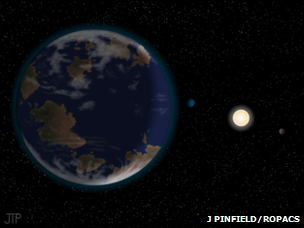'Super-Earth' exoplanet spotted 42 light-years away
- Published

An artist's conception shows what astronomers hope to confirm: water and an atmosphere at 40307g
Astronomers have spotted another candidate for a potentially habitable planet - and it is not too far away.
The star HD 40307 was known to host three planets, all of them too near to support liquid water.
But research to appear in Astronomy and Astrophysics, external has found three more - among them a "super-Earth" seven times our planet's mass, in the habitable zone where liquid water can exist.
Many more observations will be needed to confirm any other similarities.
But the find joins an ever-larger catalogue, external of more than 800 known exoplanets, and it seems only a matter of time before astronomers spot an "Earth 2.0" - a rocky planet with an atmosphere circling a Sun-like star in the habitable zone.
HD 40307, which lies 42 light-years away, is not particularly Sun-like - it is a smaller, cooler version of our star emitting orange light.
But it is subtle variations in this light that permitted researchers working with the Rocky Planets Around Cool Stars (Ropacs) network to find three more planets around it.
The team used the Harps instrument at the European Southern Observatory's La Silla facility in Chile.
Harps does not spot planets directly - it detects the slight changes in colour of a stars' light caused by planets' gentle gravitational tugs - the "redshift" and "blueshift" that small motions cause.
Most recently, the instrument was used to spot an exoplanet circling our second-nearest stellar neighbour, Alpha Centauri B.
It is by its nature a high-precision measurement, and it has only been with the team's improved analysis of the natural variations in HD 40307's light that the team could unpick just how many tugs were changing it.
"We pioneered new data analysis techniques including the use of the wavelength as a filter to reduce the influence of activity on the signal from this star," said University of Hertfordshire researcher and lead author of the paper Mikko Tuomi.
"This significantly increased our sensitivity and enabled us to reveal three new super-Earth planets around the star known as HD 40307, making it into a six-planet system."
The outermost of the three new finds, HD 40307g, orbits the star in about 200 Earth-days and has a mass at least seven times that of Earth, joining a growing class of exoplanets called super-Earths.
The team say that the next step is to used space-based telescopes to get a more direct look at the planet and assess its composition.
- Published17 October 2012
- Published28 March 2012